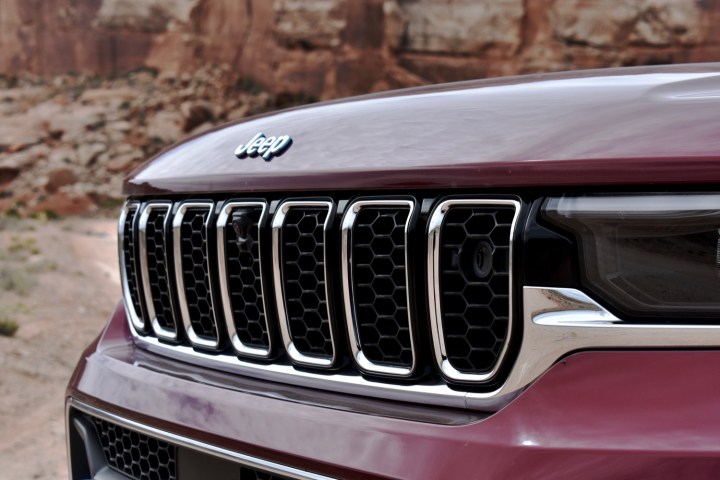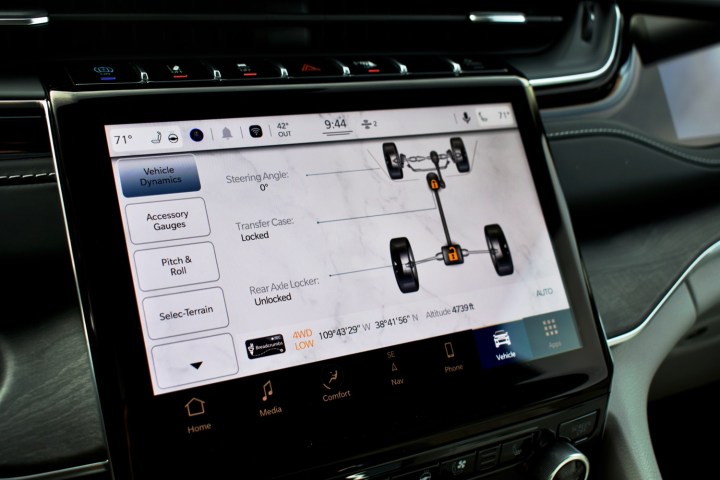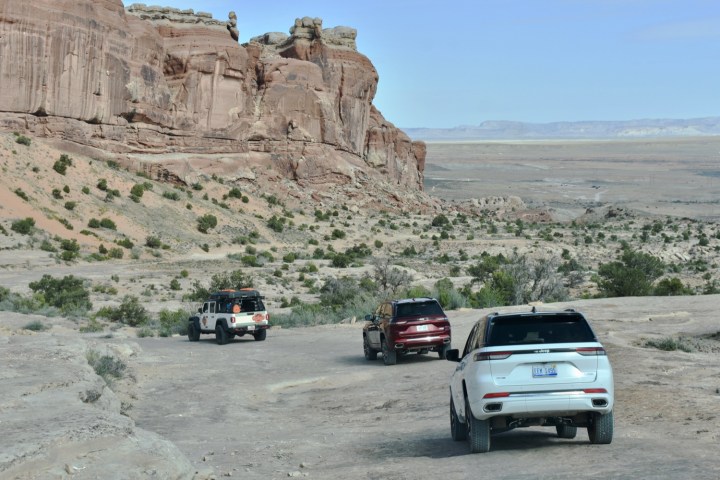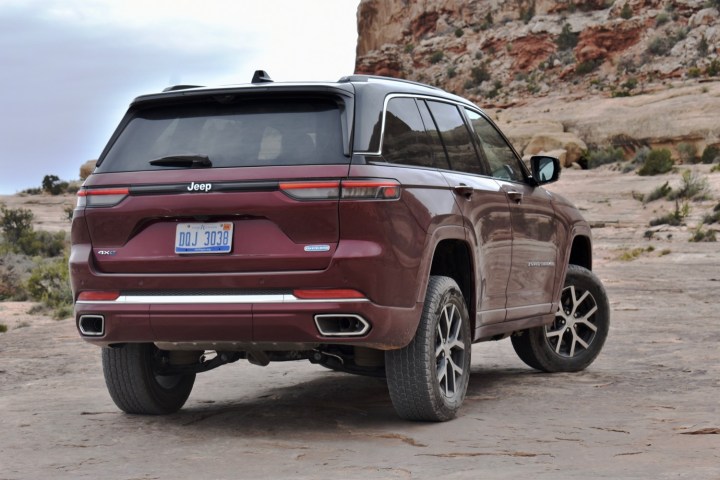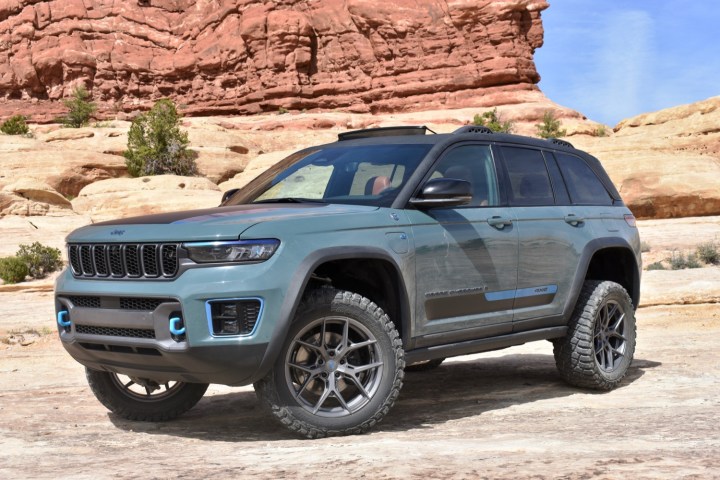For an activity that takes place in nature, off-roading doesn’t have a particularly green image. Most electric cars weren’t designed to venture into the wilderness that their zero-emission powertrains are ostensibly protecting, leaving that territory to gas guzzlers. The most famous name in off-road vehicles aims to change that.
Like most other automakers, Jeep faces pressure to reduce fuel consumption and keep investors happy at a time when EV upstarts like Tesla and Rivian have become stock- market darlings. So Jeep is looking to electrify its lineup while maintaining its off-road heritage. All-electric SUVs are in development, but Jeep is starting with plug-in hybrids, which have gasoline engines but can still drive a significant distance on electric power.
Jeep launched a plug-in hybrid version of its iconic Wrangler last year, and is following that up with the 2022 Grand Cherokee 4xe. The automaker is so confident that the Grand Cherokee 4xe is the real deal that it invited Digital Trends to the off-road mecca that is Moab, Utah, to test it out on the trails.
Jeep’s home away from home
Shot through with trails that are the legacy of uranium mining, and abutting Canyonlands and Arches national parks, Moab is an off-road playground. Jeep executives refer to it as the brand’s home away from home, and that’s certainly the case during the annual Easter Jeep Safari.
Started in 1967 by the Moab Chamber of Commerce, and currently hosted by the Red Rock 4-Wheelers four-wheel drive club, Easter Jeep Safari started out as a one-day trail drive. It’s since grown into a nine-day event that attracts off-road enthusiasts from around the country. Jeep uses the event for promotional purposes, showing off a handful of concept vehicles every year and inviting media to test out its latest production models.
Jeep turned us loose on a roughly two-mile trail near Courthouse Rock that included a mix of slick rock and sand, not to mention gorgeous desert scenery. And we did this drive without using even a drop of gasoline.
The Grand Cherokee goes plug-in hybrid
Jeep added the Grand Cherokee 4xe plug-in hybrid model to the lineup as part of a recent redesign of the popular SUV. While it does have a fairly large 17-kilowatt-hour battery pack that nets the full $7,500 federal EV tax credit and allows for 25 miles of electric range, the 4xe is a Jeep first and a plug-in hybrid second.
The powertrain, consisting of a 2.0-liter turbocharged four-cylinder engine and eight-speed automatic transmission with electric assist, is coupled to a traditional mechanical four-wheel drive system. So the 4xe has a transfer case with low range like a standard Grand Cherokee, as well as an electronic limited-slip differential. This allows power to be shunted to whatever wheels have traction, as well as for the use of low gearing that lets the 4xe crawl over loose surfaces without breaking traction.
The plug-in hybrid system doesn’t affect packaging, either. With the available air suspension pumped up to the maximum ride height, the most hardcore Grand Cherokee 4xe Trailhawk model has 10.9 inches of ground clearance, a 35.7-inch approach angle, 22.3-inch breakover angle, and 30-inch departure angle, according to the spec sheet. Gasoline Grand Cherokee models improve on some of those figures slightly, but still help ensure the 4xe doesn’t get hung up on obstacles.
For this drive, though, Jeep provided us with a Grand Cherokee 4xe Overland rather than the full Trailhawk. A more mainstream model, the Overland has different front and rear fascias that affect approach and departure angles, but it still has Jeep’s mechanical four-wheel drive, air suspension, all-terrain tires, and steel skid plates to protect the drivetrain and battery pack.
Hitting the trail
With the Overland already jacked up to its full off-road height, we hoisted ourselves into the driver’s seat and immediately switched into electric mode, silencing the gasoline engine. We then pointed the Jeep at a rock shelf, climbed up with help from a spotter, and fell into a convoy behind two other Grand Cherokees and a guide in a Jeep Gladiator pickup truck. We didn’t have to give the powertrain a second thought.
In electric mode, the 4xe didn’t throw out any surprises, allowing us to concentrate on choosing the right line to avoid getting stuck, and staying on the trail to avoid trampling plants or soil. We had no issues keeping the 4xe in electric mode, either. While the gasoline engine will automatically kick in under heavy throttle, we didn’t encounter a situation where that became necessary. That did occur on a previous drive where extra throttle was needed to maintain momentum up steep inclines, however. Otherwise, the only limiting factor is battery charge, and we had plenty of that on this drive.
All of this made for a fairly normal, drama-free off-roading experience. But electric power didn’t just match the drivability of internal combustion. It provided some extra benefits as well.
Sound of silence
As much as we love a good exhaust note, off-roading is simply better with a silent electric motor. Without the distraction of engine noises, it was easier to appreciate the scenery we were driving through. It was almost like hiking, but with air conditioning.
As with every discussion of electric motors, Jeep executives were quick to point out the benefits of instantly- available torque. While internal-combustion engines need to rev up to produce peak torque, with an electric motor, it’s available at the slightest twitch of your big toe. It’s the secret behind the organ-tenderizing acceleration of a Tesla Model S or Lucid Air, but in an off-road vehicle, it allows for smoother application of power at low speeds.
We experienced the importance of this by switching between all-electric mode and E-Save, which switches on the gasoline engine to preserve battery charge. It was much easier to control acceleration with the electric motor than the gas engine, which had a peaky power delivery that unsettled the Grand Cherokee. That not only made for a bumpier ride as weight shifted, but also increased the possibility of wheelspin, which could have left us stuck.
We’ll take the steady flow of torque and silent power delivery of an electric motor any day. Electric off-roading is the best off-roading.
Possibilities and problems
Not every owner wants to keep their SUV stock, and Jeep is trying to address that as well. One of the 2022 Easter Jeep Safari concepts was a Grand Cherokee 4xe Trailhawk with larger 33-inch tires that made it easier to climb over things than in the stock version. While the wheel wells and fenders were modified for clearance, Jeep noted that no changes were made to the air suspension system. It’s a good indication that 4xe owners will be able to modify their vehicles just like other Jeep owners.
Jeep plans to unveil its first all-electric production model in 2023, and will roll out more EVs for global markets through 2025. These electric models will likely require a different approach than just bolting electric motors to existing architectures, as with the 4xe plug-in hybrids and the all-electric Wrangler Magneto concepts, which were never intended for production.
The Grand Cherokee 4xe and its Wrangler 4xe sibling can get drivers to the trailhead on gasoline power and allow for electric off-roading, but for future EVs, Jeep will likely need to improve efficiency in order to deliver a usable amount of real-world range. Exactly how that will happen is unclear.
Other companies have already started building electric off-roaders. The Rivian R1T pickup truck offers 314 miles of range and, as we found out in a first drive, serious capability. It shows what can be done with a dedicated EV platform. Alternatively, GMC stuffed an oversized battery pack into the Hummer EV to get a claimed 329 miles of range, but that resulted in a roughly 9,000-pound behemoth that will only be built in fairly small numbers.

Another factor is charging. Jeep has partnered with Electrify America on solar-powered charging stations at trailheads. Solar power means these stations don’t have to be connected to the grid so they can be placed in remote locations easily and provide clean electricity. That network hasn’t been built out yet, however. While Jeep said last year that it was opening one site in Moab, it used a portable charger to keep vehicles topped up for this drive.
When Digital Trends asked Jeep CEO Christian Meunier about other plans to build up charging infrastructure, he only said that Jeep remains “committed” to supporting charging without offering further details. Considering the underdeveloped state of the national charging network even in well-traveled urban corridors, a lot of work remains to be done to get Jeep drivers off the beaten path on electric power.
So while it is exciting to see an off-road mainstay like Jeep embrace electrification, and the Grand Cherokee 4xe offered a tantalizing taste of electric off-roading, it will probably be a long time before experiences like ours become commonplace.
Editors’ Recommendations


